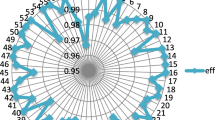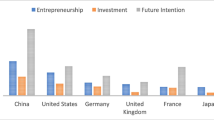Abstract
Entrepreneurship, which is referred to as the most determinant factor in economic development, has been scrutinized throughout this study. Apart from the indisputable applicability of various statistical methods in the different fields of science, this paper attempts to find the roots of the inefficient steps of entrepreneurial activities using a nonparametric and linear model named data envelopment analysis (DEA). The present article tries to identify the distinct phases during the process of running a business from start to output(s). Following this objective, three basic and different steps were found in the process of launching a business. First is the step of converting from attitude to action. This step focuses on the efficiency of entrepreneurship when attitudes help people to become entrepreneurs. Second, this step includes all entrepreneurial activities which finally bring innovative products and services, generate jobs, provide conditions for exports, etc. Third, this step focuses on the effect of entrepreneurship on the gross domestic product (GDP) per capita, as a final output in the business market. To sum it all up, this paper used a new term named “entrepreneurship overall efficiency” to assess the efficiency of entrepreneurship attitude that focuses on the effect of entrepreneurial attitudes on the final output of an entrepreneurship system namely GDP per capita. The data used throughout this study is collected from the dataset gathered by Global Entrepreneurship Monitor (GEM) in the year 2018. As the most important outshot raised from this research, it is worth noting that the parallel assessment of all four computed stages during an entrepreneurship process will provide an idiosyncratic opportunity to researchers and policymakers to identify the obstacles in economic growth.




Similar content being viewed by others
Notes
Decision-making unit (DMU) is a specified unit (e.g., organization, firm, entity, company, hospital, an individual) which is taking input(s) and after doing determined processes, creates output(s). In addition, making decisions to change in inputs and outputs are of its abilities which are mainly carried out by directors. For example, by considering a country as a DMU, it can be said that individual factors (such as entrepreneurial attitude, individual entrepreneurial abilities) and environmental factors (such as financial support and government policies in context of entrepreneurship) are the main inputs and, furthermore, economic status can be considered the output caused by the entrepreneurial inputs.
According to Zbierowski (2011), efficiency is the proportion of the sum of weighted outputs to the sum of weighted inputs.
The Global Entrepreneurship Monitor considers individuals between the ages of 18 and 64 years as the study population.
Abbreviations
- GEM:
-
Global Entrepreneurship Monitor
- DEA :
-
data envelopment analysis
- GDP:
-
gross domestic product per capita
- TEA :
-
total early-stage entrepreneurial activities
- EB :
-
established businesses ownership
- WEF :
-
World Economic Forum
- NFCs :
-
National Framework Conditions
- SMEs :
-
small and medium enterprises
- EFCs :
-
Entrepreneurial Framework Conditions
- DMU :
-
decision-making unit
- BCC:
-
Banker, Charnes, and Cooper
- CCR :
-
Charnes, Cooper, and Rhodes
References
Acs, Z. J. (1992). Small business economics: a global perspective. Challenge, 35, 38–44.
Ajzen, I. (1985). From intentions to action: a theory of planned behavior. In J. Huhl & J. Beckman (Eds.), Will; performance; control (psychology); motivation (psychology) (pp. 11–39). Berlin and New York: Springer-Verlag.
Ajzen, I. (1991). The theory of planned behavior. Organizational Behavior and Human Decision Processes, 50(2), 179–211.
Aldrich, H. E. (1979). Organizations and environments. Englewood Cliffs: Prentice Hall.
Bal, H., Örkcü, H. H., & Çelebioğlu, S. (2010). Improving the discrimination power and weight dispersion in the data envelopment analysis. Computers and Operations Research, 37(1), 99–107.
Banker, R. D., Charnes, A., & Cooper, W. W. (1984). Some models for estimating technological and scale inefficiencies in data envelopment analysis. Management Science, 30, 1078–1092.
Bates, T. (1997). Race, self-employment and upward mobility: an illusive American Dream. Baltimore: John Hopkins University Press.
Bratnicki, M., & Dyduch, W. (2005). Measuring entrepreneurship and linking it with performance. Refereed paper presented at the Institute for Small Business & Entrepreneurship 28th National Conference, Blackpool.
Busenitz, L. W., Gomez, C., & Spencer, J. W. (2000). Country institutional profiles: unlocking entrepreneurial phenomena. Academy of Management Journal, 43, 994–1003.
Capelleras, J. L., & Rabetino, R. (2005). Determinants of new firm employment growth: evidence from Latin America. Refereed paper presented at Institute for Small Business & Entrepreneurship 28th National Conference, Blackpool.
Charnes, A., Cooper, W. W., & Rhodes, E. (1978). Measuring the efficiency of decision makingunits. European Journal of Operational Research, 2, 429–444.
Charnes, A., Cooper, W. W., Lewin, A. Y., et al. (1994). Data envelopment analysis. Boston Dordrecht/London: Kluwer Academic Publisher.
Cooper, W. W., Ruiz, J., & Sirvent, L. I. (2007). Choosing weights from alternative optimal solutions of dual multiplier dual models in DEA. European Journal of Operational Research, 180, 443–458.
Cyert, R. M., & March, J. G. (1963). A behavioral theory of the firm. Englewood Cliffs: Prentice Hall.
Davidsson, P. (2003). The domain of entrepreneurship research: some suggestions. In J. A. Katz & D. A. Shepherd (Eds.), Cognitive approaches to entrepreneurship research, Advances in entrepreneurship, firm emergence and growth (Vol. 6, pp. 315–372). Oxford: Elsevier science.
Davidsson, P., & Wiklund, J. (1997). Values, beliefs and regional variations in new firm formationrates. Journal of Economic Psychology, 18, 179–199.
Doran, J., McCarthy, N., & O’Connor, M. (2018). The role of entrepreneurship in stimulating economic growth in developed and developing countries. Cogent Economics & Finance, 6, 1. https://doi.org/10.1080/23322039.2018.1442093.
Faghih, N., Bonyadi, E., & Sarreshtehdari, L. (2019). Global entrepreneurship capacity and entrepreneurial attitude indexing based on the Global Entrepreneurship Monitor (GEM) Dataset, Globalization and Development, 13–55.
Harber, D. (2003). Foundation of entrepreneurship and economic development. Routledge ISBN 0-203-350215-5 Master e-book ISBN.
Herbig, P. A. (1994). The innovation matrix: culture and structure prerequisites to innovation. Westport: Quorum.
Hofstede, G. (1980). Culture's consequences: International differences in work-related values. Beverly Hills: Sage.
Howard, L. W., & Miller, J. L. (1993). Estimating pay equity in professional baseball with data envelopment analysis. Academy of Management Journal, 36, 882–894.
Jack, S., Hyman, J., & Osborne, F. (2005). Culture and growth in a low-tech entrepreneurial small firm. Refereed paper presented at Institute for Small Business & Entrepreneurship 28th National Conference, Blackpool.
Jahanshahloo, G. R., Hosseinzadeh, L. F, Jafari, Y., & Maddahi, R. (2011). Selecting symmetric weights as a secondary goal in DEA cross-efficiency evaluation, 35, 544–549.
Janssen, F. (2006). Do manager’s characteristics influence the employment growth of SMEs? Journal of Small Business and Entrepreneurship, 19, 293–315.
Jarzębowski, S. (2013). Parametric and non-parametric efficiency measurement–the comparison of results. Metody Ilościowe w Badaniach Ekonomicznych, 14(1), 170–179.
Kirzner, J. (1973). Competition, and entrepreneurship. Chicago: University of Chicago Press.
Kolvereid, L. (1992). Growth aspirations among Norwegian entrepreneurs. Journal of Business Venturing, 7, 209–212.
Kostova, T. (1997). Country institutional profiles: concept and measurement. Academy of Management Best Paper Proceedings: 180–189.
Lazear, E. (2004). Balanced skills and entrepreneurship. American Economic Review, 94, 208–211.
Lumpkin, G. T., & Dess, G. G. (2001). Linking two dimensions of entrepreneurial orientation to firm performance: the moderating role of environment and industry life cycle. Journal of Business Venturing, 16, 429–451.
Mardani, A., Zavadskas, E., & Streimikiene, D. (2017). A comprehensive review of data envelopment analysis (DEA) approach in energy efficiency. Renewable and Sustainable Energy Reviews, 70, 1298–1322. https://doi.org/10.1016/j.rser.2016.12.030.
Mkuna, E., & Baiyegunhi, L. J. (2019). Analysis of the technical efficiency of Nile perch (Lates niloticus) fishers in the Tanzanian portion of Lake Victoria: a stochastic frontier analysis. Lakes & Reservoirs: Research & Management, 24(3), 228–238.
Moreira, G. C., Kassouf, A. L., & Justus, M. (2018). An estimate of the underreporting of violent crimes against property applying stochastic frontier analysis to the state of Minas Gerais, Brazil. Nova Economia, 28(3), 779–806.
Phillips, Y. R. (1992). Systems and management science by extremal methods. Boston: Kluwer Academic Press.
Ramanathan, R. (2005). An analysis of energy consumption and carbon dioxide emissions in countries of the Middle East and North Africa. Energy, 30, 2831–2842.
Schumpeter, J. A. (1934). The theory of economic development: An inquiry into profits, capital credit, interest, and the business cycle. Cambridge: Harvard University Press.
Seiford, L. M. (1996). Data envelopment analysis: the evolution of state of the art (1978-1995). Journal of Production Analysis, 7, 99–137.
Sexton, D. L., & Smilor, R. W. (1997). Entrepreneurship 2000: 401–408. Chicago: Upstart Publishing.
Sexton, T. R., Silkman, R. H., & Hogan A.J. (1986). Data envelopment analysis: critique and extension.
Shane, S. A. (1993). Cultural influences on national rates of innovation. Journal of Business Venturing, 8, 59–73.
Sims, M. A., & O’Regan, N. (2006). In search of gazelles using a research DNA model. Technovation, 26, 943–954.
Starbuck, W. H. (1976). Organizations and their environments. In M. D. Dunette (Ed.), Handbook of industrial and organizational psychology (pp. 1069–1123). Chicago: Rand McNally.
Stoica, O., Roman, A., & Rusu, V. D. (2020). The Nexus between entrepreneurship and economic growth: a comparative analysis on groups of countries. Sustainability, 12(3), 1186.
Van Praag, C. M. (2005). Successful entrepreneurship, confronting economic theory with empirical practice. Glos: Edward Elgar.
Wiklund, J., & Shepherd, D. (2003). Aspiring for, and achieving growth: the moderating role of resources and opportunities. Journal of Management Studies, 40, 1919–1941.
Zbierowski, P. (2011). The positive potential of high performance organization. JPM, 2(1). https://doi.org/10.12775/JPM.2011.009.
Acknowledgements
We are grateful to the reviewers for their wonderful comments and suggestions throughout the review process. Additionally, we highly wish to thank our family for encouraging us during this research.
Availability of data and material
The reports and dataset on individual and environmental factors affecting the entrepreneurship status, released by the Global Entrepreneurship Monitor (GEM), and the data relating to the Gross Domestic Product (GDP) per capita calculated in the year 2018 have been used throughout this study.
Author information
Authors and Affiliations
Contributions
Nezameddin Faghih: The main ideas behind the paper have been developed by him and also he acted as the supervisor trying to improve the structures of this article.
Ebrahim Bonyadi: Conceptualization; methodology; software (including R programing language, and SPSS); validation; formal analysis; data curation; writing—original draft; writing—review and editing; supervision; project administration.
Lida Sarreshtehdari: investigation; resources; formal analysis; writing—original draft; visualization; project administration.
Corresponding author
Ethics declarations
Competing interests
The authors declare no competing interests.
Rights and permissions
About this article
Cite this article
Faghih, N., Bonyadi, E. & Sarreshtehdari, L. Assessing the entrepreneurship process: an application of the data envelopment analysis. J Glob Entrepr Res 11, 311–327 (2021). https://doi.org/10.1007/s40497-021-00289-8
Received:
Accepted:
Published:
Issue Date:
DOI: https://doi.org/10.1007/s40497-021-00289-8




